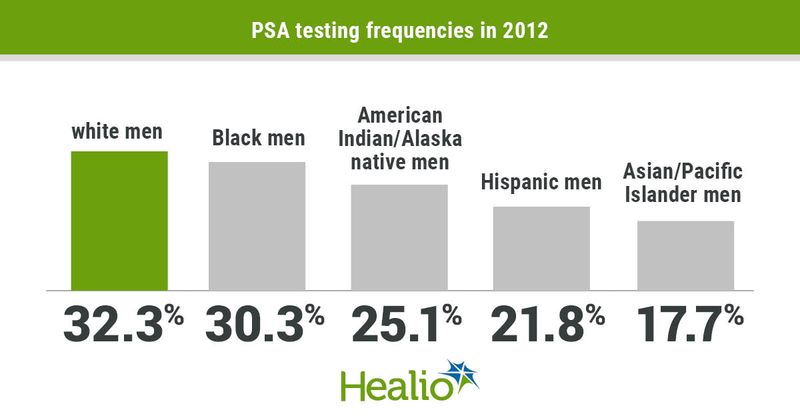Declines in prostate cancer screening after 2012 USPSTF guidance vary by race, ethnicity
Prostate cancer screening rates appeared to differ among Black, white, Hispanic and Asian/Pacific Islander men following the 2012 U.S. Preventive Services Task Force recommendation against routine PSA testing, according to study results.
“Widespread uptake in serum PSA-based screening contributed to a 40% decrease in prostate cancer mortality from the mid-1980s through 2000. However, adoption of PSA testing led to a spike in prostate cancer incidence over this period, during which many otherwise indolent tumors were detected and received treatments associated with adverse effects,” Kevin H. Kensler, ScD, researcher in the division of population sciences at Dana-Farber Cancer Institute, and colleagues wrote in the study, published in Journal of the National Cancer Institute. “The USPSTF maintained a recommendation of ‘insufficient evidence’ through much of the 1990s and early 2000s, citing a lack of randomized trial evidence. ... The 2012 USPSTF recommendation against routine PSA testing led to a decrease in prostate cancer screening, but the heterogeneity of its impact by race and ethnicity remains unclear.”

Kensler and colleagues sought to examine this potential impact by analyzing trends in PSA testing among 404,122 men (67.4% white; 13.7% Hispanic; 10.6% Black; 4.2% Asian/Pacific Islander; 3% of other or unknown race/ethnicity; 1% American Indian/Alaska Native) aged 40 to 74 years with no history of prostate cancer. The researchers acquired data from Behavioral Risk Factor Surveillance System surveys for 2012, 2014, 2016 and 2018 and estimated the proportion of men who self-reported receiving a routine PSA test during the past year. They then estimated ORs of undergoing screening by race and ethnicity, after adjusting for health care-related factors.
SEER registry data from 2004 to 2017 enabled researchers to assess prostate cancer incidence rates and rate ratios according to race and ethnicity.
Survey results showed a decline in the proportion of men who reported PSA testing in the past year, from 29.9% (95% CI, 29.4-30.4) in 2012 to 20.4% (95% CI, 19.9-20.9) in 2018, an absolute difference of 9.5%. After adjusting for age, the odds of undergoing a screening PSA test decreased by 10% annually (OR = 0.9; 95% CI = 0.89-0.91) starting in 2012, and after adjusting for socioeconomic status and health care-associated factors, odds of testing decreased by 11% annually (OR = 0.89; 95% CI, 0.88-0.89).
In the 2012 survey, white men had the highest rate of PSA testing, at 32.3% (95% CI, 31.7-32.8), followed by 30.3% (95% CI, 28.3-32.3) for Black men, 25.1% (95% CI, 20.3-29.9) for American Indian/Alaska native men, 21.8% (95% CI, 19.9-23.7) for Hispanic men and 17.7% (95% CI, 14.1-21.3) for Asian/Pacific Islander men.
The decline in absolute screening frequency between 2012 and 2018 was greater among Black men than white men (11.6% vs. 9.3%). The relative annual decrease in odds of PSA testing also was greater among Black men (OR = 0.86; 95% CI, 0.84-0.88) compared with white men (OR = 0.89; 95% CI, 0.89-0.9; P for heterogeneity = .005). This difference appeared to be fueled by a greater decrease in testing among Black men aged 40 to 54 years (15%; OR = 0.85; 95% CI, 0.82-0.88) compared with white men in that age group (12%; OR = 0.88; 95% CI, 0.87-0.89).
Further, researchers found that incidence rates of distant disease increased for all racial and ethnic groups since 2010, with a slower increase among Black men (annual percent change = 2.7; 95% CI, 1.4-3.9) than white men (annual percent change = 5.6; 95% CI, 4.6-6.7).
The incidence rate ratio for total prostate cancer of Black men vs. white men increased from 1.73 (95% CI, 1.69-1.76) in 2011 to 1.87 (95% CI, 1.83-1.92) in 2012 and continued to increase thereafter, according to the researchers, largely due to differences in localized tumor incidence.
Limitations of the study included the fact that the Behavioral Risk Factor Surveillance System utilizes self-reported receipt of PSA testing, the accuracy of which is lower than that of other screening modalities, the researchers noted.
“The Behavioral Risk Factor Surveillance System indicated that there is approximately two-fold variation in PSA-based prostate cancer screening frequency across racial and ethnic groups,” Kensler and colleagues wrote. “Moreover, the 2012 USPSTF recommendation against PSA testing was associated with a continued decline in PSA testing since 2012 and modest growth of the difference in screening frequency between Black and white men.”
The decreases in screening among Black men or associated increases in adverse disease at diagnosis would not have been observed had a screening guideline been established for this population, according to an editorial accompanying the study by Ruth Etzioni, PhD, researcher at Fred Hutchinson Cancer Research Center, and Yaw A. Nyame, MD, MS, MBA, researcher in the department of urology at University of Washington Medical Center.
“At a time of acute awareness of health inequity and in a new era of precision cancer control, the issuance of prostate cancer screening guideline tailored to Black men must rank as a high priority for an easily implementable policy solution,” Etzioni and Nyame wrote. “[The analysis by Kensler and colleagues] is telling us that it is high time for national prostate cancer early detection panels to step up and meet this moment.”
References:
Etzioni R and Nyame YA. J Natl Cancer Inst. 2020;doi:10.1093/jnci/djaa172.
Kensler KH, et al. J Natl Cancer Inst. 2020;doi:10.1093/jnci/djaa171.
